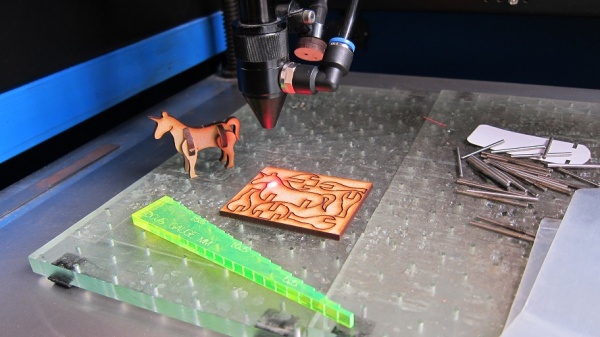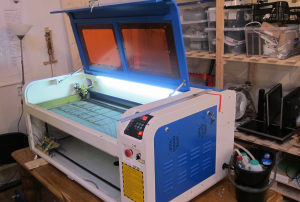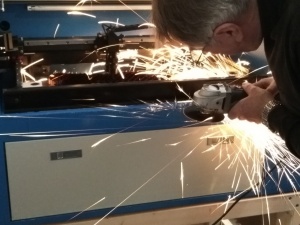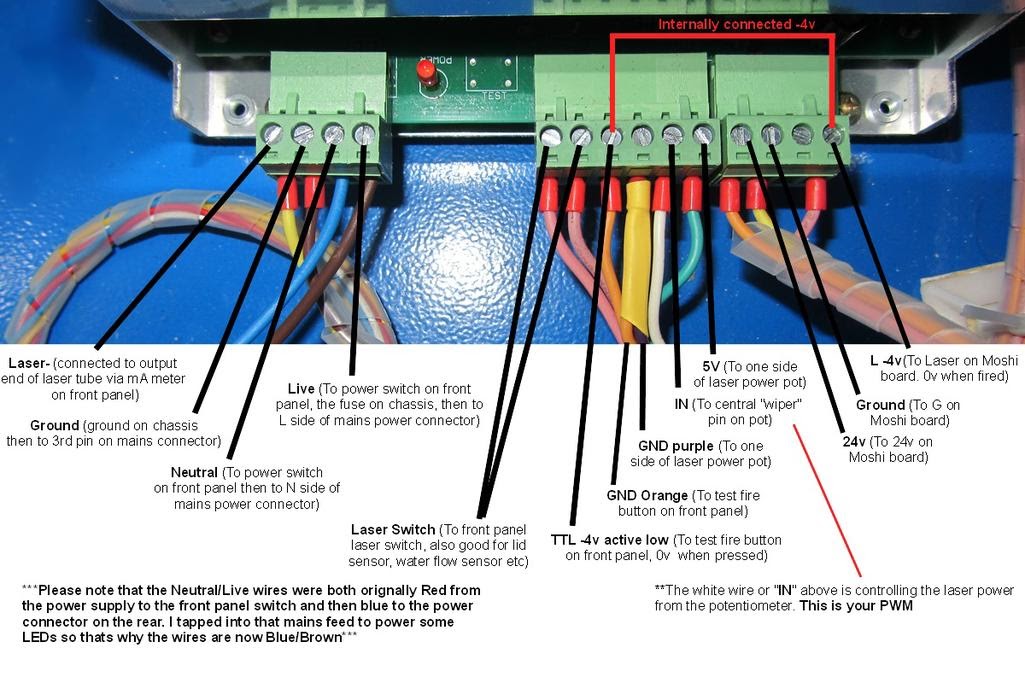Difference between revisions of "Laser Cutters"
m (→Non-critical) |
m (→Useful Gcode) |
||
| Line 106: | Line 106: | ||
(note there are no far end endstops - wide jobs with errant 0s may punch out!) | (note there are no far end endstops - wide jobs with errant 0s may punch out!) | ||
| + | |||
| + | |||
| + | |||
| + | 'to fire at 10% power for 1/10 second you would input G1 Z1 F600 S0.2' | ||
| + | |||
</pre> | </pre> | ||
Revision as of 18:37, 29 May 2018
Usage
Use of this equipment is strictly for trained members only, before use, users MUST attend an induction. Incorrect use of this equipment can cause serious harm or death, or worse, break our lasers. If you are not inducted do not touch. Especially do not touch any wires or open the casings, the dragons are fed on distilled lightening, and believe me it can jump.
This page is not an instruction manual, but more a reference and reminder.
Tips relevant to both lasers
Keep an eye on the smoke. If you see smoke pooling in the cutter this may indicate that the fan covers have jammed, or you forgot to turn it on - consult Mr Laserducky to verify this. Power cycle the extraction fan to hopefully fix it.
If smoke is solely departing from the top of your workpiece, you probably haven't fully cut through it. Check before removing it! If so, do the same cut again but five times faster; unless you completely hosed the settings, you probably have less than a millimetre of material left in place.
If the laser is performing unusually poorly, consider:
Is it focussed properly? Is the air assist set up correctly? Is the laser coolant over temperature (should be <15 degrees) Does it have the lens in there that you believe it does? Do the mirrors or lens need cleaning?
Acrylic is a strange material to cut. As a plastic, it will sometimes melt itself together again after cutting; slow speeds prevent this, so even if a higher speed, higher power pass looks like it would be more efficient, it will not work as you would intuitively expect.
The plastic window in the lid absorbs the cutting beam's particular wavelength, so from that view it is safe to watch - however the light generated by the act of cutting can sometimes be bright enough to cause concern, much like burning magnesium or similar. It may also be worth mentioning that we have no idea what class of laser the guide beams are, and it often reflects at the user, unhindered by the lid. Staring at either for too long is inadvisable. There is a lot that can be said about the safety of running them open, but the very short version is, don't do it. The cutout switches are there for a reason.
Both RDWorks and Laserweb can send files to a laser that somebody else is using, which can ruin projects - always check to see that it isn't in active use before accessing or sending data.
If the laser starts cutting something it should be doing later, and is likely to cause drop-out of something else that needs cutting/etching, it is possible to very quickly toggle power to the laser beam, which creates a manual tab holding the item in place. Not ideal, but it can save workpieces.
Helios
Purchased as broken, and without any software, within the day we had it cutting again, and up to full original operational condition before the weekend was out. One of our more notable achievements!
Helios is the axe to Selene's scalpel. Cutting bed size is 100*45, tube is ~90 watts, and the exact cutting limits are unknown yet, pending a different lens. Whilst we could probably cut wood up to an inch thick with this tube and a long lens, it would also immediately catch fire. Helios uses a 20mm lens, usually it's armed with a 1.5" PC, which means the focal distance is about 16mm. Brute Mode focal distance yet to be established.
Using this for actual work is not possible until we sort out fume extraction airflow and proper cooling, then finish documenting the software and workflows needed. Again this will change as soon as we can make it happen!
Preliminary documentation
The short version: go to Laserweb and upload R12 ASCII DXF files made in your program of choice (SVGs can work too, see below). Then load the documents into the work area, and click the arrow in the top right position to move it to the positive x & y axis. Set your cutting parameters, and generate the gcode. Switch to the Comms tab and make sure you're connected, then lastly, the Control tab to run your job.
Due to both hardware and software limitations, Helios should only be used for vector operations, eg cutting and scoring from DXF or SVG file data. In brief, the gantry and bearings are not precise enough for the detail needed in dithered images, and the Laserweb software chokes when sending the data, causing huge bottlenecks which pause the operation constantly; since we have a very powerful dragon under the hood, that will lead to a bad end.
Saving DXFs
Inkscape can save many files as DXF types - best options are as yet unknown.
Fusion can save sketches as DXF, simply right-click the sketch name in the browser and choose the option. Note that construction lines may be caught up, if so this can be worked around via projecting the geometry or body outlines into a clean sketch and saving that.
Note that DXFs are not all created equal. You may find that spline data and other useful features are lost upon import to Laserweb, if so use Draftsight to open and re-save them as R12 ASCII format, and try again.
SVGs
'Some' SVG lines are ignored for output. Reasons unknown, pending further investigation. It's certainly nothing obvious.
Laserweb will also take Inkscape-made SVGs, but text must be converted to path data first, via the object menu, otherwise it will be lost. Illustrator SVGs will work with some minor caveats. If you experiment with other SVG generators please document your findings.
Unknown factors
Homing after job completed (done in laserweb now) Can some sort of beep/feedback be issued on job completion? 'Barking'/jamming and panicking when doing 'quick' moves, eg long distance Home and Frame commands. Smoothie needs a maximum speed set and tested to prevent this.
To do:
Blocking
Identify and purchase a suitable long focal lens. Fix the Y axis mirroring issue! Make / cut test board to work out material power levels (done) Cut a test square to see if 50cm IS 50cm both in dimensions and squareness Level the bed, it's more than trivially out of alignment (done. that was a serious hassle -_-) Cross airflow needs addressing Cooling. At the least we need to monitor what temperature the bucket's getting to!
Non-critical
Clean the windows! Aiming pointer fixing / tuning (partly done) Through-beam crosshairs (in progress) Under-gantry lighting Anchor the bed mesh (done - there is wiggle on the anchors however though! need to wrench the final nuts tighter, fiddly as we have no M4 spanners.) Acquire flat sheet to cover the bed mesh... Update the GUI movement arrows if possible, to point in the correct direction. Is it possible to remove the printing related buttons? Needs a pulse button - I cannot find the gcode to trigger the damn thing though. The fire testing command doesn't work either, with or without m1000. Safety cutout Better 'pistons'
Useful Gcode
( http://marlinfw.org/docs/gcode/M203.html | http://smoothieware.org/motion-control )
switch.buzzer.enable true switch.buzzer.input_on_command M42 switch.buzzer.input_off_command M43 switch.buzzer.subcode 1 switch.buzzer.output_pin 0.25 switch.buzzer.output_type pwm Execute "M42.1 S100" to turn it on Execute "M43.1" to turn it off G1 F1500 ; set the feedrate to 1500mm/minute Set max feedrate for XY to 100mm/s: M203 X100 Y100 gcode to zero: G92 X0 Y0 Z0 (note there are no far end endstops - wide jobs with errant 0s may punch out!) 'to fire at 10% power for 1/10 second you would input G1 Z1 F600 S0.2'
Selene
Our original, smaller laser; quick and precise. Best for engraving and detail work; cutting area is 500*300mm, tube is 40 watts. Cutting limit is 6mm in most materials.
A user guide can be found here
Using more than 65% power is usually inadvisable. The tube is underrated so that is almost at the safe maximum. The actual output difference between 65% and 75% is minimal, and over 75% is overdriving the tube, e.g. it's at maximum output and you're just throwing more power at it anyway. Using more than 75% power is a really bad idea and you shouldn't be doing it ever.
Software
You need to use RDWorks to prepare and send your design to the machine - it is installed already on both of the PCs. It can be downloaded from here so you can prepare laser files at home and use the Makerspace time more efficiently. Note that the software is Windows only.
The design that you wish to cut can be designed in almost any vector graphics program, as long as the result is saved as a DXF file.
Autocad, Draftsight, Inkscape and so forth are good choices for both editing and conversion.
For non-trivial projects, the file should ideally be layered, with layers setup for each type of cut. We would usually recommend three layers as follows:
- Cutting, all inner cuts
- Cutting, the outer perimeter, i.e. the last cut so the material does not fall out before all the inner cuts are complete
- Etching, anything to be etched, i.e. text and images.
Once loaded into RD Works, the layers can be ordered to ensure the outer cut is last. Usually though, for simple cutting operations RD Works can be trusted to order the operations sensibly to prevent dropout of uncut parts, without the need for layer management.
Bed cleaning
Clean the Acorn nuts with soapy water, and the bed with methylated spirits. Once dry give it a quick wipe with 3-in-1 applied with a tissue, if you do not do this, it will develop a skin of rust within days, flecking work with brown muck.
Settings for common materials
Pending updates
- 3mm Acrylic
- Cut
- Power = 30 %
- Speed = 10mm/s
- Note that not all acrylics are created equal. Transparent acrylic in particular needs a little less speed.
- Etch
- Power = 20 %
- Speed - 200mm/s
- Cut
- 3mm ply
- tbc
- 6mm ply
- tbc
- Cardboard
- Cut
- Power = 30%
- Speed = 20mm/s
- Note that the offcuts from this fall and end up igniting later! Ensure you remove them.
- You may need to turn down the blower, to prevent embers being fanned into flames.
- Note harder that corrugated cardboard loves to catch fire if the blower blasts air through the channels. Must be watched constantly!
- Cut
Materials
Materials NOT to cut
| Material | DANGER! | Cause/Consequence |
|---|---|---|
|
Emits chlorine gas when cut! | Don't ever cut this material as it will ruin the optics, cause the metal of the machine to corrode, and ruin the motion control system. It may also kill us; chlorine gas can turn to HCl on the lens, turning it into hydrogen selenide gas. |
| Thick ( >1mm ) Polycarbonate/Lexan | Cuts very poorly, discolours, catches fire | Polycarbonate is often found as flat, sheet material. The window of the laser cutter is made of Polycarbonate because polycarbonate strongly absorbs infrared radiation! This is the frequency of light the laser cutter uses to cut materials, so it is very ineffective at cutting polycarbonate. Polycarbonate is a poor choice for laser cutting. |
| ABS | Melts | ABS does not cut well in a laser cutter. It tends to melt rather than vaporize, and has a higher chance of catching on fire and leaving behind melted gooey deposits on the vector cutting grid. It also does not engrave well (again, tends to melt). |
| HDPE/milk bottle plastic | Catches fire and melts | It melts. It gets gooey. Don't use it. |
| PolyStyrene Foam | Catches fire | It catches fire, it melts, and only thin pieces cut. This is the #1 material that causes laser fires!!! |
| PolyPropylene Foam | Catches fire | Like PolyStyrene, it melts, catches fire, and the melted drops continue to burn and turn into rock-hard drips and pebbles. |
| Fiberglass | Emits fumes | It's a mix of two materials that can't be cut. Glass (etch, not cut) and epoxy resin (fumes) |
| Coated Carbon Fiber | Emits noxious fumes | A mix of two materials. Thin carbon fiber mat can be cut, with some fraying - but not when coated. |
Laser safe materials
The laser can cut or etch. The laser can cut materials like wood, paper, cork, and some kinds of plastics. Etching can be done on almost anything, wood, cardboard, stainless steel, some plastics, marble, stone, tile, and glass.
Cutting
| Material | Max thickness | Notes | WARNINGS! |
|---|---|---|---|
| Many woods | 6mm (1/4") | Avoid oily/resinous woods. Hardwood/heavy duty cutting will require many passes and the gulley thus formed is a firetrap. Consider 'etching' cuts instead with a cut setting but low power and high speed, then band/jig/scrollsawing. | Be very careful about cutting oily woods, or very resinous woods as they also may catch fire. |
| Plywood/Composite woods | 6mm (1/4") | These contain glue, and may not laser cut as well as solid wood. | |
| MDF/Engineered woods | 6mm (1/4") | These are okay to use but may experience a higher amount of charring when cut. | |
| Paper, card stock | thin | Cuts very well on the laser cutter, and also very quickly. | |
| Cardboard, carton | thicker | Cuts well but may catch fire. Remove all fragments! Blower may need disabling. | Watch for fire. |
| Cork | 6mm (1/4") | Cuts nicely, but the quality of the cut depends on the thickness and quality of the cork. Engineered cork has a lot of glue in it, and may not cut as well. | Avoid thicker cork. |
| Acrylic/Lucite/Plexiglas/PMMA | 12mm (1/2") | Cuts extremely well leaving a beautifully polished edge. | |
| Thin Polycarbonate Sheeting (<1mm) | <1mm | Very thin polycarbonate can be cut, but tends to discolour badly. Extremely thin sheets (0.5mm and less) may cut with yellowed/discoloured edges. Polycarbonate absorbs IR strongly, and is a poor material to use in the laser cutter. | Watch for smoking/burning |
| Delrin (POM) | thin | Delrin comes in a number of shore strengths (hardness) and the harder Delrin tends to work better. Great for gears! | |
| Kapton tape (Polyimide) | 1.5mm (1/16") | Works well, in thin sheets and strips like tape. | |
| Mylar | 1.5mm (1/16") | Works well if it's thin. Thick mylar has a tendency to warp, bubble, and curl | Gold coated mylar will not work. |
| Solid Styrene | 1.5mm (1/16") | Smokes a lot when cut, but can be cut. | Keep it thin. |
| Depron foam | 6mm (1/4") | Used a lot for hobby, RC aircraft, architectural models, and toys. 1/4" cuts nicely, with a smooth edge. | Must be constantly monitored. |
| Gator foam | Foam core gets burned and eaten away compared to the top and bottom hard paper shell. | Not a fantastic thing to cut, but it can be cut if watched. | |
| Cloth/felt/hemp/cotton | They all cut well. Our lasers can be used in lace-making. | Not plastic coated or impregnated cloth! | |
| Leather/Suede | 3mm (1/8") | Leather is very hard to cut, but can be if it's thinner than a belt (call it 1/8"). | Real leather only! Not 'pleather' or other imitations! |
| Magnetic Sheet | Cuts beautifully | ||
| NON-CHLORINE-containing rubber | Fine for cutting. | Beware chlorine-containing rubber! | |
| Teflon (PTFE) | thin | Cuts OK in thin sheets. See https://www.ulsinc.com/materials/teflon ; the issues listed in https://en.wikipedia.org/wiki/Polymer_fume_fever should not matter because our lasers are fully vented and exhausted. | |
| Carbon fiber mats/weave that has not had epoxy applied |
Can be cut, very slowly. | You must not cut carbon fiber that has been coated!! | |
| Coroplast ('corrugated plastic') | 6mm (1/4") | Difficult because of the vertical strips. Three passes at 80% power, 7% speed, and it will be slightly connected still at the bottom from the vertical strips. | Due to PSU issues we probably don't want to be cutting this currently. Also ensure it is polypropylene plastic, not PVC! |
Etching
All the above "cuttable" materials can be etched, in some cases very deeply.
In addition, you can etch:
| Material | Notes | WARNINGS! |
|---|---|---|
| Glass | Green seems to work best...looks sandblasted. | Only FLAT GLASS can be engraved in our cutter. No round or cylindrical items. |
| Ceramic tile | ||
| Anodized aluminium | Vaporizes the anodization away. | |
| Painted/coated metals | Vaporizes the paint away. | |
| Stone, Marble, Granite, Soapstone, Onyx. | Gets a white "textured" look when etched. | 100% power, 50% speed or less works well for etching. |
Test files
We have carried out a number of tests on common materials, we will publish the settings is the software section above, if you wish to carry out further tests, the test files can be downloaded from Boss Laser.
Suppliers of materials
Other Learning Resources
Servicing
Lens and the mirrors need cleaning, ideally we need lint-free cloth for this - note that the mirrors are molybdenum, which is a very soft metal. The lens itself is likely zinc selenide, which is both toxic, brittle and fragile. A drop onto any surface, including something soft, can scratch or break it - be very careful if you have cause to touch it.
Alignment videos; coarse alignment https://www.youtube.com/watch?v=5YvOqH44n6c and the more relevant part 2 which deals with the 'mirror' stage of the problem https://www.youtube.com/watch?v=pl6dAWOkksM . Actual mirror alignment, eg squaring the beam path to the axis: https://www.youtube.com/watch?v=Vl6QKlwRKlk .
Laser MOT; https://www.youtube.com/watch?v=wupSN8mXlus
Once we have an ammeter, we need to have a fiddle to work out our power/output curves. https://www.youtube.com/watch?v=nZuatc3eIgU and https://www.youtube.com/watch?v=j5cIFxGu_1g for more information.
To break things with some authority, this is a useful reference. Note that the 'test' button fires the laser.
Aiming device information: https://www.youtube.com/watch?v=Jm8syz6ARCY & https://www.youtube.com/watch?v=r4GfdS4GDqs



